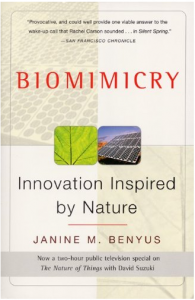Biomimicry: Innovation Inspired by Nature
Review by Alan F Kay
Biomimicry by Janine Benyus deals with the clear and fascinating, yet little understood and vast, reality of the processes of life and living beings. The book summarizes these ideas this way:
Virtually all living creatures: plants, animals, microbes, etc., rely on energy mostly based on sunlight but also on affects squeezed from their own and other species in air, water, land, or combinations. Species survive and expand by using the functions of their own needs but, more importantly, in the long run best survive by mostly fitting into the needs and usage of other living beings. This includes recycling, diversification, and cooperation that depends on the local expertise of reality.
These processes for all living creatures have gone on for millions of years while significant changes occur generally within time frames of thousands of years.
Readers turn your thinking away from all-life and shift just to humans. That’s us.
When humans evolved from other primates, the planet’s human population, initially a handful of people, grew into ever increasingly larger numbers of humans who were hunter-gatherers. Further enlargement increased as the successful benefits of farming and agriculture required the settlements of ever more people.
Then rapidly a mere few hundreds years ago, the industrial age began, initially a small part of all humanity that evolved into an ever growing fraction of people. Finally about a mere one or two hundred years ago, that fraction grew to be significant over large sections of the planet. In a relatively short period of time, a rapidly growing group of humans arose who were increasingly wealthy.
The Biomimicry book explains how we humans can improve our operations in three major areas, (1) growing our food, (2) making our materials, and (3) getting the energy (electricity, etc.) that we need. The book shows that these three major areas are clearly improved by understanding Nature’s way based on the methods of those people, before the industrial age, who slowly over thousands of years learned for themselves what best handled their needs, and those methods can beneficially improve the three major areas for us humans now.
Furthermore business needs to be conducted in a way that the many benefits included in the book reach business to receive virtually all the other benefits as explained in the book.
The book goes through a thousand or more specific details of all these relationships. Much of it has been reinforced by widely located human experts, companies and individuals knowledgeable in sciences relevant to the work that they have cooperatively discussed, and reinforced in the book
Here is a simplified example: A single molecule that has been created by attracting and attaching onto a small number of individual molecules thus existing in the “nano” range or smaller (imagine here a simple example, H2O, water) is modified by the attachment to another single molecule (say nitrogen, appearing on the periodic table as the letter N). The process creates an enlarged molecule that may have existed before, but may have never been produced as a single new molecule before. When that enlargement has been done for a single molecule, the next step is a required replication into millions of identical molecules, a process that is achieved by the capacity and capability of a well-designed laboratory. Such capacity and capability has only been possible to accomplish recently — within the last decade or so. Time in Biomimicry is moving more quickly than ever.
Benyus has spawned a worldwide network of practitioners licensed in her biomimicry methods. Her Biomimicry Institute offers a 2 year Master’s degree and shorter courses for middle-management company executives to help re-design materials, products and processes. Biomimicry is helping evolve industrial methods toward greater efficiency and working with Nature’s tolerances.
Thus book is a classic which belongs on the shelf of all concerned with the shift to cleaner, greener, sustainable societies.

